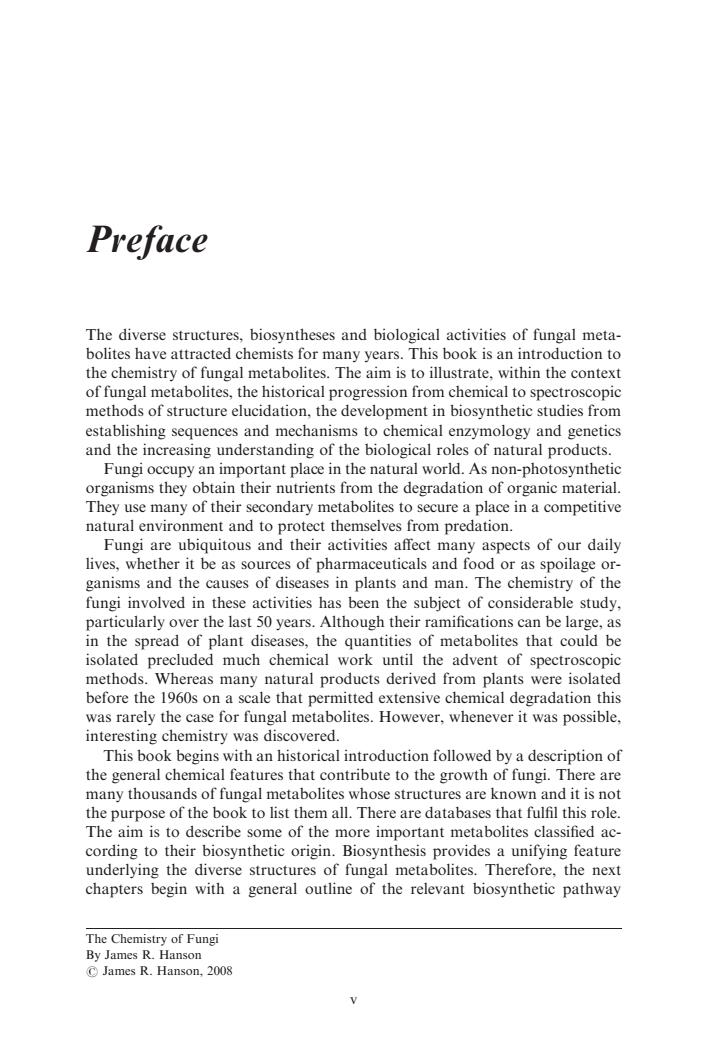正在加载图片...

Preface The diverse structures. and bioloicl activities of fungal meta bolites have attracted chemists for many years.This book is an introduction to the chemistry of fungal metabolites.The aim is to illustrate,within the context of fungal metabolites,the historical progression from chemical to spectroscopic methods of structure elucidation,the development in biosynthetic studies from establishing sequences and mechanisms to chemical enzymology and genetics and the increa of the biologica o products Fur tosynth They use many of their secondary metabolites to secure a place in a competitive natural environment and to protect themselves from predation. Fungi are ubiquitous and their activities affect many aspects of our daily lives,whether it be as sources of pharmaceuticals and food or as spoilage or- ganisms and the causes of diseases in plants and man.The chemistry of the fungi involved in these activities has been the subject of considerable study. ars.Alt ough their ions can be large the spread of plant dise the qu metabo s that could be solate d precluded much chem work adven of spectroscopic methods.Whereas many natural products derived from plants were isolated before the 1960s on a scale that permitted extensive chemical degradation this was rarely the case for fungal metabolites.However,whenever it was possible, interesting chemistry was discovered. This book begins with an historical introduction followed by a description of the ge neral cher ical features that contribute to the growth of fungi.There are many thousands se stru ind it is n the purpose of the b k to list them all.There are databas The aim is to describe some of the more important metabolites classified ac cording to their biosynthetic origin.Biosynthesis provides a unifying feature underlying the diverse structures of fungal metabolites.Therefore,the next chapters begin with a general outline of the relevant biosynthetic pathway The Chemistry of Fungi By James R.Han C James R.Hanson.2008Preface The diverse structures, biosyntheses and biological activities of fungal metabolites have attracted chemists for many years. This book is an introduction to the chemistry of fungal metabolites. The aim is to illustrate, within the context of fungal metabolites, the historical progression from chemical to spectroscopic methods of structure elucidation, the development in biosynthetic studies from establishing sequences and mechanisms to chemical enzymology and genetics and the increasing understanding of the biological roles of natural products. Fungi occupy an important place in the natural world. As non-photosynthetic organisms they obtain their nutrients from the degradation of organic material. They use many of their secondary metabolites to secure a place in a competitive natural environment and to protect themselves from predation. Fungi are ubiquitous and their activities affect many aspects of our daily lives, whether it be as sources of pharmaceuticals and food or as spoilage organisms and the causes of diseases in plants and man. The chemistry of the fungi involved in these activities has been the subject of considerable study, particularly over the last 50 years. Although their ramifications can be large, as in the spread of plant diseases, the quantities of metabolites that could be isolated precluded much chemical work until the advent of spectroscopic methods. Whereas many natural products derived from plants were isolated before the 1960s on a scale that permitted extensive chemical degradation this was rarely the case for fungal metabolites. However, whenever it was possible, interesting chemistry was discovered. This book begins with an historical introduction followed by a description of the general chemical features that contribute to the growth of fungi. There are many thousands of fungal metabolites whose structures are known and it is not the purpose of the book to list them all. There are databases that fulfil this role. The aim is to describe some of the more important metabolites classified according to their biosynthetic origin. Biosynthesis provides a unifying feature underlying the diverse structures of fungal metabolites. Therefore, the next chapters begin with a general outline of the relevant biosynthetic pathway The Chemistry of Fungi By James R. Hanson r James R. Hanson, 2008 v